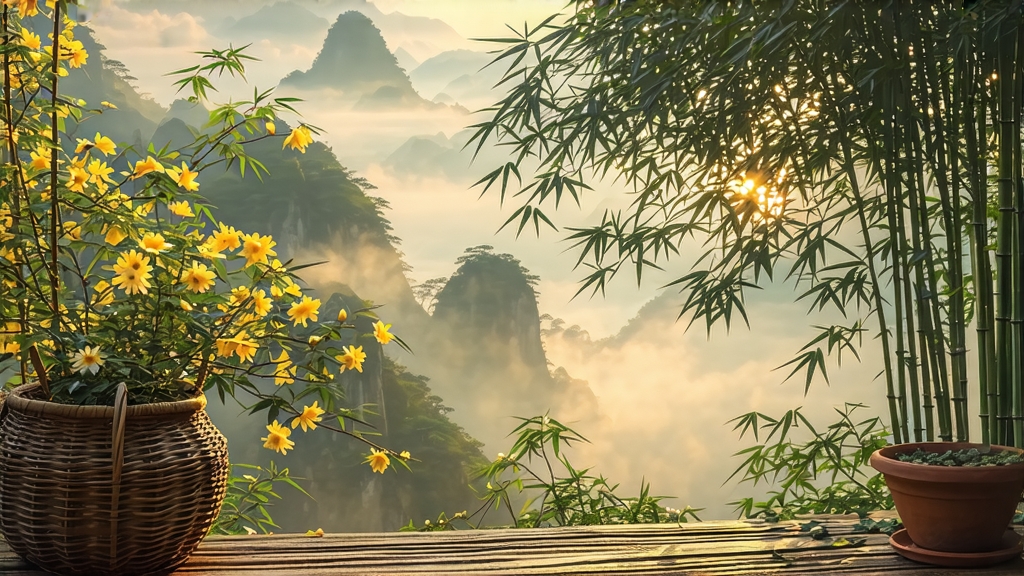
Tucked high above the Sichuan basin, where perpetual cloud veils the Min River gorge, Meng Ding Huang Ya has been quietly perfecting its golden character for twelve centuries. International drinkers who cherish the bright grassiness of green tea or the honeyed depth of white tea often overlook the narrow yellow-tea corridor that lies between them; yet this single bud-and-leaf, coaxed through a labor-intensive “sealed yellowing” process, delivers a cup that is neither green nor white, but a mellow, apricot-hued liquor once reserved for Tang-dynasty emperors. To understand Meng Ding Huang Ya is to witness Chinese tea craft at its most patient and precise: a dance of moisture, heat and time that turns young spring buds into tiny ingots of flavor.
History: from altar to altar
Meng Ding Mountain, literally “Peak of the Hazy Summit,” rises 1 456 m at the western edge of the Chengdu plain. Buddhist monks planted the first tea gardens here during the Tang era (618-907 CE), and by 724 CE the leaf was already listed among the nine “altar teas” presented to the imperial court. A Song-dynasty edict (1162) explicitly demanded that “the yellow buds of Meng Ding” be sent to Kaifeng before the Qingming festival; failure to meet the deadline was punishable by law. Carried along the Min River, then transferred to the Grand Canal, the tea traveled 2 000 km in bamboo-lined chests cushioned with wet paper so that the slow oxidation begun on the mountain would continue en route, deepening the yellow color that so delighted the palace. After the fall of the Qing, production lapsed; only in 1959 did the Sichuan Tea Research Institute re-establish the original cultivar and revive the forgotten yellowing technique. Today fewer than 300 households on the mist-shrouded northern slope are licensed to sell leaf under the Meng Ding Huang Ya denomination, making each harvest one of the rarest sanctioned teas in China.
Cultivar & terroir
The plant itself is a local variant of Camellia sinensis var. sinensis known as “Meng Ding Xiao Ye Zhong” (small-leaf Meng Ding). Its narrow, thick blades evolved under cool, foggy mornings and ultraviolet-rich altitude, storing amino acids while retarding catechins—precursors to the tea’s signature sweetness. Soils are yellow-brown laterite rich in iron and manganese, drained by countless mountain springs. Temperature swings of 10 °C between day and night slow growth, concentrating flavor in the dormant bud. Gardens lie between 800 m and 1 400 m; any higher and the yellowing step becomes unreliable, any lower and the fragrance thins.
Plucking standard
True Meng Ding Huang Ya is picked only five days each year, from 20–24 March, when the bud reaches 15–20 mm but the first leaf remains half-unfurled, resembling a swallow’s tongue. Pickers work before 09:00, when dew still shields the enzymes from sunlight. A skilled woman can gather 600 g of fresh buds in three hours; 4.2 kg of this is required to finish 1 kg of dry tea.
Craft: the lost 48-hour yellowing
The defining phase is “men huang” (sealed yellowing), a controlled micro-fermentation unknown to green or white tea. After kill-green at 160 °C for 90 seconds—just enough to halt oxidative enzymes—the hot leaf is immediately piled in linen sacks (5 kg each) and slid into a pine-lined chamber kept at 28 °C and 75 % RH. For the next two nights the tea master refuses sleep, turning the sacks every 90 minutes so that the inner temperature never exceeds 34 °C; at dawn he fans the mouth of the chamber to admit cool mountain air. During this interval chlorophyll degrades into pheophytin, catechins dimerize into theaflavins, and a faint maillard note of toasted rice emerges. On the third morning the leaf is withdrawn, kneaded for eight minutes at 60 °C to set the curl, then gently oven-dried at 45 °C until moisture falls to 7 %. The finished bud is straw-yellow with a downy silver tip; when rubbed it releases an aroma of fresh corn silk and lilies.
Grades & nomenclature
- Ming Qian Huang Ya: picked before Qingming, bud only, 6 mm uniform length, 8 000 buds per